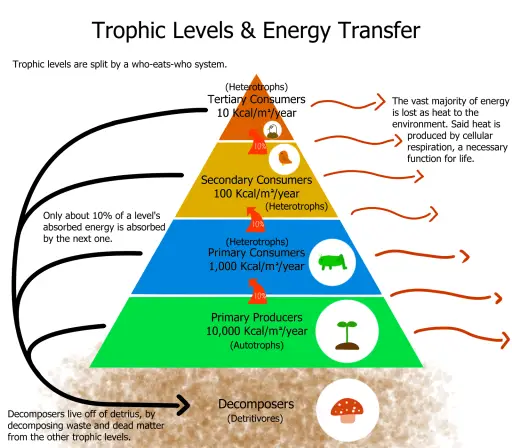Ecosystem Structure and Dynamics
When all organisms in a community are influenced by the abiotic environment with which the organisms interact, an ecosystem is established. Ecosystem ecologists are interested in energy flow, the transfer of energy through the components of the ecosystem, and chemical cycling, the transformation of matter in the ecosystem.
Both energy flow and chemical cycling involve the transfer of substances through the trophic levels of the ecosystem. However, energy flows through and out of ecosystems while the matter is recycled within ecosystems. Doesn’t this remind you of the laws of conservation of energy and matter?
Energy Production and the Energy Pyramid
Most life on Earth relies on the Sun for energy. Of the visible light that reaches photosynthetic organisms, only 1% of it is used for primary production, the conversion of solar energy into chemical energy through photosynthesis.
Counting the total amount of primary production in a given time period is called gross primary production, expressed in units of energy or units of biomass (which are often the mass of the vegetation in the area).
Producers use some of the energy in cellular respiration so what is left is the net primary production. This remainder is the energy that can be given to an ecosystem in a given period, so it is like the budget of chemical energy available to consumers.

You might have already seen an energy pyramid. It illustrates the energy loss with each transfer in a food chain. Each tier in the pyramid represents the chemical energy present in all organisms at one trophic level of a food chain and the width of each tier indicates how much of the energy from the tier below are incorporated into their own biomass.
What you may have been familiar with is the idealized pyramid where 10% of the energy is transferred to the next trophic level. In nature, such efficiencies usually range from 5 to 20% while the remainder is lost to the environment. An implication of this is that the amount of energy for the top consumers is smaller than lower-level consumers.
You can observe this with lions and hawks which require large territories as it takes a lot of vegetation to support many trophic levels. Energy pyramids help us understand why most food chains are limited to three to five levels; there is simply insufficient energy at the top of the pyramid to support another trophic level.
We have tackled the flow of energy in ecosystems. In the next topic, we will look into chemical cycling which involves the transformation of matter.
Next topic: The Biogeochemical Cycles
Previous topic: Ecological Succession
Return to the main article: The Principles of Ecology
Download Article in PDF Format.
Test Yourself!
1. Practice Questions [PDF Download]
2. Answer Key [PDF Download]
Copyright Notice
All materials contained on this site are protected by the Republic of the Philippines copyright law and may not be reproduced, distributed, transmitted, displayed, published, or broadcast without the prior written permission of filipiknow.net or in the case of third party materials, the owner of that content. You may not alter or remove any trademark, copyright, or other notice from copies of the content. Be warned that we have already reported and helped terminate several websites and YouTube channels for blatantly stealing our content. If you wish to use filipiknow.net content for commercial purposes, such as for content syndication, etc., please contact us at legal(at)filipiknow(dot)net